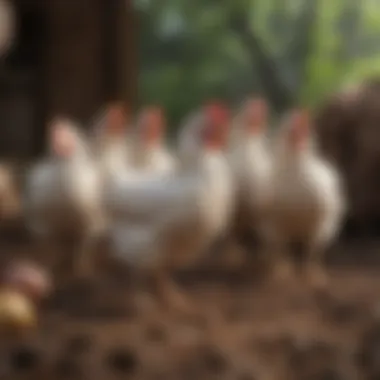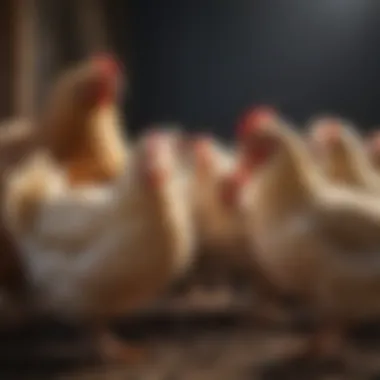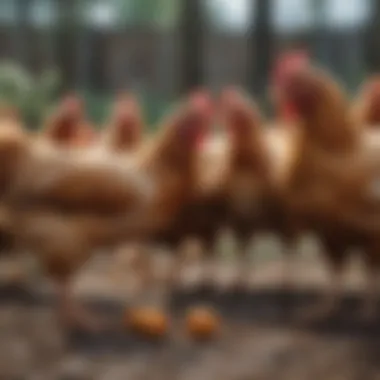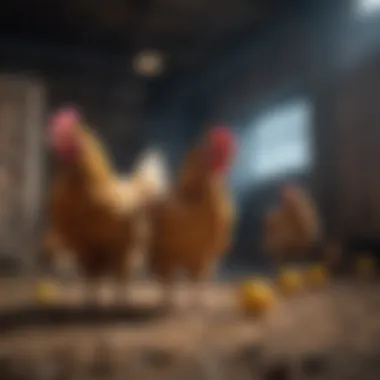Successful Integration of Young Chickens into Flocks


Intro
As flock owners, it is imperative to understand the behaviors of both mature and younger chickens. This knowledge allows for successful management strategies that foster harmony. Additionally, awareness of nutritional needs and medical care for younger chickens is necessary to maintain a healthy environment. In this article, we will explore vital considerations, best practices, and useful insights into this integration process.
Grooming Techniques
While grooming younger chickens may not be the first thought during integration, it holds importance for their health and social standing. Proper grooming can enhance the physical appearance of the birds, prevent diseases, and help them fit in.
Basic Grooming Tools
Some essential tools for grooming chickens include:
- Comb: For smoothing feathers.
- Blower: To remove loose dirt and debris.
- Nail Clippers: For trimming overgrown nails.
- Brush: For cleaning and checking for parasites.
Having the right tools ensures an effective grooming session, allowing younger chickens to feel clean and comfortable.
Step-by-Step Grooming Guides
Here is a simple process for grooming younger chickens:
- Select a Calm Area: Find a quiet space with minimal distractions.
- Handle With Care: Gently hold the chicken, supporting its body.
- Check for Parasites: Look through feathers for signs of lice or mites.
- Brush Feathers: Use the brush to smooth the feathers. Be gentle to avoid causing stress.
- Trim Nails: If necessary, carefully trim the nails to a safe length.
- Check Overall Health: During grooming, observe signs of distress, injury, or illness.
Regular grooming helps young chickens adapt better to their new environment and to the established flock.
Breed-Specific Grooming Needs
Different breeds may have varying grooming requirements. For instance:
- Silkies: Require more frequent grooming due to their delicate feather structure.
- Leghorns: Need less grooming as their feathers are more resilient.
Understanding these needs helps in tailoring care strategies during integration.
Health and Wellness
The health of younger chickens during integration cannot be overlooked. Proper diet and regular check-ups are essential in ensuring a smooth transition.
Nutrition and Diet Tips
A balanced diet is crucial for younger chickens. They require:
- Protein-Rich Feed: Supports growth and development.
- Vitamins and Minerals: Essential for immune health.
- Fresh Water: Access to clean water is vital at all times.
Common Health Issues and Solutions
Some common health issues to watch out for include:
- Coccidiosis: A parasitic infection that affects the intestinal tract.
- Respiratory Infections: Can transmit quickly in flocks.
Early detection and treatment can prevent the spread of disease.
Importance of Regular Check-Ups
Routine check-ups with a veterinarian help monitor health and catch potential problems early. Vaccinations and health assessments should be standard practice when introducing younger birds.
Training and Behavior
Understanding behavior patterns is integral to a successful integration. Older chickens may react differently to newcomers, necessitating strategies to manage their interactions.
Basic Training Commands
Establishing basic commands helps in managing younger chickens. Commands like “come” and “stay” can be helpful during integration to ensure safety and control.
Understanding Common Behavioral Issues
Some behaviors to notice include:
- Pecking Order Establishment: Younger birds may be picked on as they integrate.
- Stress Indicators: Signs can include excessive vocalization or withdrawal.
Techniques for Effective Training


Use positive reinforcement to encourage desired behaviors. Treats given for calmness or social interactions can promote positive integration among flock members.
Community Insights
Incorporating insights from fellow chicken owners can provide practical tips and tricks for integration. Engaging with communities on forums like Reddit or Facebook can reveal real-life experiences that add value to the learning journey.
User-Submitted Tips and Tricks
- Gradual Introductions: Start by letting younger and older birds see each other without direct contact.
- Separate Quarters: Initially keep them in adjoining pens to get accustomed.
Understanding Flock Dynamics
Understanding flock dynamics is crucial when integrating younger chickens into an existing group. The interactions and relationships among chickens greatly influence their overall well-being and productivity. A successful integration requires recognizing the unique social structure that each flock has developed over time. Without this understanding, the process can lead to significant stress for both the new and existing members.
The behaviors exhibited by chickens are deeply rooted in their social hierarchy. They establish connections that determine how they interact with one another. Therefore, it is vital to comprehend these dynamics to facilitate a smoother transition when introducing younger chickens.
The Significance of Social Structure
The social structure within a chicken flock is not merely a grouping but a complex system that affects every aspect of their lives. This structure determines the pecking order, feeding times, and even nesting habits. Understanding this hierarchy helps avoid conflicts that can arise during integration.
- Hierarchy Awareness: Existing chickens often have established roles within the flock. Recognizing who the dominant and submissive birds are can help minimize potential conflicts during integration.
- Environmental Impact: The spatial layout and resource availability within the coop can influence social interactions. Observing how chickens interact in their environment provides insight into how younger birds may fit in.
- Behavioral Expectations: Different chickens may display various behaviors once a newcomer arrives. Knowing the norms created by the flock can help anticipate reactions to newcomers.
In short, appreciating the significance of social structure can significantly enhance the integration process.
Establishing Pecking Order
Establishing a consistent pecking order is central to the social interactions in a chicken flock. This order is defined by the dominance and submission observed among the birds.
- Initial Reactions: When younger chickens enter an established flock, the initial encounters may be marked by pecking and chasing. These actions are part of forming the pecking order.
- Stress Levels: Understanding how younger chickens experience this process is imperative. They may exhibit signs of stress or submission, and monitoring these behaviors is essential.
- Observation: Close observation during the integration period allows for timely intervention if aggression levels become concerning. By watching how established flock members react, owners can gauge how successful or problematic the integration may be.
It is advisable to provide temporary neutrality. Create separate spaces for the newcomers while they adjust. Over time, the established chickens will begin to view younger birds as part of their flock rather than intruders.
Preparing for Preamble
Preparing for the introduction of younger chickens to an established flock is a crucial step in ensuring a smooth transition. Many aspects must be taken into consideration to minimize stress and promote harmony. Undertaking careful preparations can set the stage for successful integration.
Assessing the Existing Flock
Before introducing new members, a thorough assessment of the current flock is necessary. Understanding the behavior and dynamics of the established chickens can help predict how they might react to newcomers.
- Take note of dominant and submissive birds. Identify those that tend to be more aggressive. This knowledge can inform strategies to mitigate potential confrontations during the integration process.
- Observe the overall health and temperament of the flock. Healthy chickens are more likely to adapt positively. Conversely, stressed or sick birds may react aggressively to newcomers, complicating matters further.
- Note the space available for the chickens. The existing quarters must support comfortable living conditions for both newcomers and current residents.
By thoroughly evaluating the existing flock, pet owners can create a tailored integration plan that considers the unique characteristics and needs of their chickens.
Choosing the Right Location for Integration
The choice of location for integration can significantly impact the success of introducing younger chickens. Selecting the right environment is essential for both safety and comfort. Here are some considerations:
- **Safe Zones: ** Ensure the location is safe from predators and that it can provide sufficient shelter from weather extremes.
- Space Considerations: The area must have enough room for established chickens to maintain their pecking order while allowing newcomers to feel secure.
- Temporary Housing: Set up a segregated space where younger chickens can stay initially. This safe space enables them to acclimate to the environment and observe their older counterparts without direct contact.
Choosing an appropriate location is a critical element in the integration process. Taking these factors into account helps to ensure a smoother transition for both the established flock and the newcomers.
Behavioral Considerations
Recognizing Signs of Stress
When introducing younger chickens to a new flock, recognizing signs of stress is essential. Chickens express stress through various behaviors. Common indicators include:
- Signs of aggression, such as pecking or chasing
- Withdrawal from the group or hiding
- Vocalizations that appear distressed, such as loud squawking
- Excessive preening or feather plucking
Monitoring stress is crucial. It helps in taking timely action to mitigate distress, which can affect the flock's health. If younger chickens are showing these signs, it might be necessary to reconsider the introduction strategy or provide them with safe spaces to retreat.
Monitoring Interaction during Preamble
Monitoring interaction during the introduction phase is a critical component of integrating younger chickens. Observing how the established flock responds to the newcomers can reveal a lot about compatibility.
Focus on:
- Body language of the chickens, such as fluffed feathers or lowered heads
- Frequency and nature of interactions, noting any trends in aggression or acceptance
Using a gradual introduction process can ease this monitoring. Start by allowing short, controlled interactions. Gradually increase the time spent together while monitoring behavior closely.


Effective monitoring can prevent conflicts, ensuring younger chickens settle comfortably into the established flock. The goal is to create an atmosphere where all birds feel safe and accepted.
Steps for Integration
Gradual Prolusion Strategy
The gradual introduction strategy is a paramount element in ensuring success when adding younger chickens. This method involves slowly introducing the newcomers to the established flock. It is crucial to minimize stress and aggression during this transition.
- Initial Isolation: Begin by keeping the younger chickens in a separate enclosure near the flock. This allows the existing chickens to become accustomed to their presence without direct contact. For about a week, observe their behaviors and relations from a distance.
- Controlled Interaction: After a period of observation, allow short periods where the younger birds can interact with the established flock under supervision. Monitor closely for any aggressive behavior. If aggression occurs, separate the birds again.
- Gradual Expansion: Increase the time spent together gradually, ensuring to provide a safe space for retreat if necessary. This gradual exposure can help prevent territorial disputes and gives both groups time to adjust to the new social dynamics.
This approach allows for fostering familiarity while minimizing potential stress from unexpected confrontations. Patience is imperative during this phase.
Utilizing Safe Spaces
Establishing safe spaces is vital during the integration of younger chickens. These designated areas act as refuges where the new chicks can escape if they feel threatened. The proper setup can greatly increase the comfort level of both groups.
- Physical Barriers: Create barriers, such as separate sections within a coop or run, to give younger chickens a safe area. These barriers help them to observe the flock without direct confrontation.
- Hiding Places: Ensure that there are hiding places like boxes or low structures. This setup allows the younger chickens to feel secure and can reduce stress when they encounter the more dominant members of the flock.
- Resource Allocation: Place food and water sources in these safe areas. Ensuring younger chickens have unchallenged access to essential resources helps promote their well-being during the integration phase.
Safe spaces contribute to a sense of security, which is vital for fostering positive relationships among the flock. They offer a buffer that helps in easing the tensions that may arise during this delicate process.
Nutritional Considerations
Nutritional considerations play a vital role in the successful integration of younger chickens into an established flock. Younger chickens have distinct dietary needs compared to adult hens. Providing the appropriate nutrition is critical for their growth, development, and overall health. Mismatches in nutrient intake can lead to stress and health issues, complicating the integration process.
Dietary Adjustments for Younger Chickens
Younger chickens require a diet rich in essential nutrients to support their rapid growth. The basic diet should focus on high-quality starter feed, which is typically higher in protein than the grower or layer feeds intended for older chickens. Starter feeds generally contain about 20-24% protein, which is essential for muscle development and feather growth.
In this phase, it is also important to include vitamins and minerals such as calcium and phosphorus, which contribute to skeletal development. A well-rounded diet may also include:
- Grains like corn and wheat, which provide energy.
- Greens such as lettuce or kale that supply vitamins and help with digestion.
- Access to grit, which assists in digestion, particularly when they begin to consume whole grains or seeds.
Consider providing the feed in small, manageable quantities to prevent wastage. This allows the younger birds to graze and ensures they receive enough nutrients without competing with older hens.
Ensuring Equal Access to Food and Water
Ensuring equal access to food and water is essential for maintaining a healthy balance during and after integration. Established chickens may assert their dominance, leading to younger birds being pushed away from food sources. This can cause malnutrition and create additional stress during the integration process.
To prevent this, consider implementing the following strategies:
- Multiple Feeding Stations: Set up several feeding areas around the coop. This ensures that younger chickens can eat without interference from dominant members of the flock.
- Various Water Sources: Similar to food, provide multiple water containers to allow all chickens to hydrate freely.
- Monitor Consumption: Observe younger birds regularly to ensure they are eating and drinking adequately. Signs of not eating include being lethargic or having poor feather condition.
By taking proactive steps, the chances of successfully integrating younger chickens with an established flock will improve significantly, promoting a healthier, more harmonious environment.
Establishing a consistent feeding and watering routine further supports a stable environment that minimizes competition. This is crucial in laying the foundation for a well-integrated flock.
Common Challenges
Fear and Aggression Dynamics
Fear and aggression dynamics are crucial elements to consider during integration. Older chickens may perceive younger ones as intruders or threats. This perception can trigger aggressive behaviors. Younger chickens, unfamiliar with the established pecking order, might exhibit fear in response to aggression. This fear can escalate stress levels in both groups.
Managing Aggression
To manage aggression, it is essential to understand the hierarchy within the flock. Older chickens typically aim to establish dominance. Understanding this hierarchy can aid in anticipating aggression triggers. The following strategies can help mitigate aggressive behavior:
- Introduce younger chickens gradually, allowing them to acclimate.
- Use visual barriers during initial introductions, reducing visibility between different age groups.
- Monitor interactions closely to intervene if necessary.
Effective management of fear and aggression can prevent injury and foster a healthier flock environment.
Physical Space Constraints
Physical space constraints can pose significant challenges during the integration process. An overcrowded environment can amplify stress and competition among chickens. Adequate space allows chickens to establish their own territory. This principle is especially important for younger birds who may need time to adapt.
Space Recommendations
To ensure sufficient space, consider the following:
- Provide separate feeding and watering stations to minimize competition.
- Create designated areas for younger chickens where they can retreat if threatened.
- Ensure the coop and run accommodate the flock's size, allowing all chickens to express natural behaviors without feeling crowded.


Incorporating these strategies will promote a smoother integration process. Addressing fear, aggression, and space constraints is vital for fostering a balanced and healthy flock.
Health Monitoring
Health monitoring in chickens is a critical component of successful integration. Younger chickens can be particularly vulnerable during their adjustment period. Close observation enables early detection of illness and promotes appropriate interventions. A healthy flock leads to a more stable environment. There are several key elements to consider when it comes to health monitoring.
Recognizing Illness in Younger Chickens
Younger chickens often show different signs of illness compared to mature birds. Changes in behavior can be one of the first indicators. For instance, if a chicken becomes withdrawn or less active than usual, it could signify an underlying health issue. Other signs to watch for include:
- Loss of appetite: Chickens that are not eating may be ill.
- Abnormal droppings: Diarrhea or unusual colors in droppings can indicate digestive problems.
- Lethargy: A lack of energy or a tendency to isolate from the flock may suggest stress or sickness.
By consistently monitoring these behaviors, owners can intervene early, preventing serious health complications that could affect the entire flock.
Vaccination Considerations
Vaccination is another important aspect of health monitoring. It helps protect younger chickens against various diseases that can spread within the flock. Developing a vaccination schedule is essential. Here are some key points to consider when planning vaccinations for younger chickens:
- Timing: It is crucial to vaccinate chickens at the right age. Some vaccinations should be administered within the first few weeks of life.
- Types of Vaccines: Common vaccines include those for Marek's disease, Newcastle disease, and infectious bronchitis. Research which vaccines are necessary in your region.
- Follow-Up: Keeping records of vaccinations can prevent overlaps or missed doses, ensuring optimal immunity.
Vaccination not only protects individual birds but also contributes to the overall health of the flock. It’s important to consult a veterinarian for tailored advice on vaccination strategies.
Effective health monitoring practices lead to a happier and more productive flock.
Timeframe for Adjustment
Understanding the Process Duration
The duration required for adjustment can vary based on multiple factors, including the age difference between chickens, previous social interactions, and the overall temperament of the existing flock. Generally, this integration phase can take anywhere from a few days to several weeks. A gradual approach benefits each chicken's emotional and physical well-being. This might include:
- Initial Isolation: Keeping the younger chickens in a separate space allows them to observe the older flock without direct interaction.
- Gradual Introduction: Slowly allowing supervised interactions helps mitigate aggressive behaviors and promotes familiarity.
- Monitoring Period: Spending time observing social cues is essential during this phase to assess any signs of distress or aggression.
Establishing a clear timeline helps manage expectations for both the owner and the chickens. Being patient can make all the difference in fostering cooperation among different age groups.
Signs of Successful Integration
Identifying the signs of successful integration is essential to ensure that younger chickens are accepted into the flock. Positive behaviors signal that the younger chickens are blending into their new environment without undue stress. Key indicators include:
- Friendly Pecking and Preening: Young chickens engaging in gentle pecking or mutual preening with the older members demonstrates acceptance.
- Eating and Drinking Together: Coexisting without competition for food and water resources indicates a positive adjustment.
- Reduced Stress Signals: Observing relaxed postures and less vocal distress means the integration process is going well.
- Exploring Together: When younger chickens wander and explore alongside their older counterparts, it suggests they feel secure.
Monitoring these signs closely allows owners to intervene if issues arise. Successful integration is ultimately about building a cohesive flock where each member feels safe and valued.
Long-term Management
Sustaining Healthy Relationships
Building and maintaining positive relationships among the flock is essential. Once younger chickens are integrated, fostering an environment of acceptance is important. Ensuring that all members feel secure will help sustain this. Here are some elements to focus on:
- Observation of Behavior: Monitor interactions regularly. Watch for signs of aggression or bullying.
- Social Engagement: Encourage interaction through group activities. This could include varying feeding times or providing play areas.
- Physical Space: Ensure that there is enough room for each chicken to establish its own space. This aids in reducing competition for resources.
- Reinforcement of Boundaries: Train your flock to respect each other’s space. Gentle reminder through presence can aid this.
Maintaining these healthy relationships may improve overall flock productivity and happiness. Understanding the individual personalities of chickens can make a significant difference in flock dynamics.
Continual Monitoring Strategies
Monitoring should not stop once younger chickens are properly integrated. This ongoing process is essential to identify any emerging issues. Here is how to approach continual monitoring:
- Health Checks: Routinely check for signs of illness. Look for any behavioral changes that could indicate health problems.
- Feeding Patterns: Observe food and water consumption levels. Ensure younger chickens are not bullied away from food resources.
- Behavioral Observations: Create a system for noting interactions. Keeping a journal can help track any recurring issues.
- Environmental Conditions: Ensure that the living conditions remain stable. Change in weather or space can affect behavior.
Regular monitoring helps identify issues before they escalate into serious problems. Addressing concerns quickly can prevent damage to flock relationships.
Through diligent long-term management, flock owners can achieve a balanced ecosystem. Focusing on these aspects will lead to robust health and happiness among both younger and older chickens.
Epilogue
Summarizing Key Insights
In this article, we examined various elements critical to a successful integration process:
- Flock Dynamics: Recognizing the existing social structure is essential. The established pecking order impacts how new birds will be received.
- Behavioral Considerations: Observing signs of stress and closely monitoring interactions are necessary to gauge the well-being of both new and existing flock members.
- Health Monitoring: Keeping an eye on the health of younger chickens, including recognizing any signs of illness, is crucial in preventing issues that can arise from stress or aggression within the flock.
- Long-term Management: Developing strategies for ongoing monitoring ensures that relationships remain stable and healthy over time.
The integration phase requires careful attention to detail. Each stage has phases that, when managed well, contribute to a thriving community of chickens.
Encouragement for Future Integrations
For owners looking to expand their flocks in the future, it is vital to remember that successful integration is achievable with planning and patience. Every introduction is unique, as each flock has its own dynamics. By applying the principles discussed in this article, owners can foster environments where new and established chickens coexist peacefully.
Consider documenting your integration experiences. Sharing successful strategies with fellow poultry owners can lead to a more informed community. Additionally, engaging with resources, such as forums on Reddit or Facebook groups dedicated to poultry management, may yield insights that enhance the integration process.







